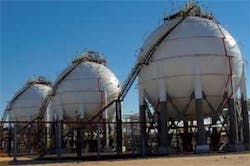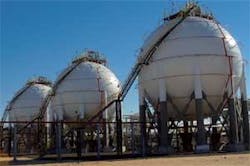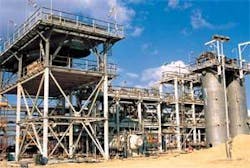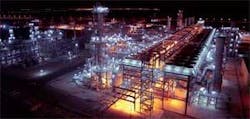The world’s energy futureat least a big part of itbelongs to natural gas. Globally, the resource is very large, and countries and consumers increasingly choose clean burning natural gas when possible.
Egypt is fortunate to have two key benefits as this future unfolds: A significant gas resource and a well-defined strategy to optimize the value of that resource, both at home and via exports. That strategy includes finding and producing more, and processing to recover liquids with high value as fuel and petrochemical feedstock.
Successes achieved by the Egyptian Natural Gas Holding Company (EGAS) in recent years attest to the wisdom of an expansion strategy for natural gas adopted by the Ministry of Petroleum, said Minister of Petroleum Eng. Sameh Fahmy recently.
During the General Assembly meeting of EGAS in September, the Minister called the expansion of the natural gas sector a corner stone in Egypt’s energy strategy.
Total natural gas reserve by end of fiscal year 2006-2007 stood at 72.3 tcf. And new finds continue to add to that reserve. For example, in mid 2007, Dana Gas (PSJC) announced a new gas and condensate discovery in its Dabayaa-1 exploration well in the West Manzala exploration concession. The well penetrated a gas-bearing interval in the Lower Abu Madi sandstone where an extensive drill stem test produced at a rate of 16.5 MMcfd and 330 b/d of condensate through a 32/64-in. choke.
Centurion Petroleum Corp., the upstream division of Dana Gas, drilled the well to a total depth of 3,001 m (9,846 ft) and encountered a hydrocarbon-bearing interval that extends over a 10 sq km (3.9 sq mile) area, according to the company.
“We are very excited about this gas discovery which confirms our high expectations for the hydrocarbon potential of the Abu Madi Formation in our concession,” said Mr. Rashid Saif Al-Jarwan, General Manager of Dana Gas.
Focus on processing
A variety of companies explore for and develop Egypt’s natural gas reserves, and Egyptian Natural Gas Co. (Gasco) is responsible for gathering, processing and transporting natural gas and gas products to a wide range of consumers.
Gasco received natural gas from production companies during 2005 totaling 38.1 billion cu m (bcm) of gas, distributed 31.6 bcm for local consumption, and exported 6.5 bcm.
New natural gas discoveries have been made in the Western Desert area. And demand for propane and ethane/propane mix to supply feedstock for expansions and future projects in the ethylene and polyethylene industry is expected to grow rapidly. With the prospect of both new supply and increased demand for high-value natural gas products, Gasco began in 2006 to implement a project to maximize production of ethane/propane mix in the Western Desert Gas Complex and the Amereya LPG recovery plant.
Mechanical works are expected to be complete by late 2008, with commissioning and start up scheduled for February 2009. Estimated total cost of the project is about US$218 million.
UGDC: A world class plant
Established in October 2001, United Gas Derivatives Co. (UGDC) is a response to the increasing international demand for natural gas. It is a result of the policy and economic model implemented by the Ministry of Petroleum for attracting foreign investments to increase production and exports. The program also will return foreign currency, helping to fund projects without burdening Egypt’s economy.
UGDC receives the gas produced from North Port Said, Temsah and Ras El-Bar concessions through the gas treatment plants of El-Gamil and Ha’py, and produces propane, LPG and condensate.
Company owners are Gasco, BP Global Investments Ltd. (BP) and ENI International B.V. (ENI), each with a one-third share.
“The relationship between the shareholders is very healthy,” said Ibrahim Ahmed, UGDC Chairman and Managing Director. “All are working towards the success of the company as most of the gas fed to the plants comes from the shareholders’ concessions.”
The goal is to meet the needs of these multinationals investors while still achieving UGDC’s corporate objectives.
“I do not see a conflict of interest between the multinational investors and our own corporate objectives,” said Mr. Ahmed. “The company works on behalf of all the shareholders to maximize revenue through safe and reliable operations.”
And safety is top priority. Since its inception in 2005, the company as accumulated 2.5 million man hours without accidents while handling about 1.1 bcfd of natural gas. “This is a world class NGL plant,” said Mr. Ahmed.
To achieve such a safety record requires keeping track of all activities, major and minor, said Mr. Ahmed, with well established and monitored procedures. For example, a tracking system monitors every car 24 hour/day to ensure compliance with speed limits.
Within the plant, there are different levels of approval both for cold and hot work. Every procedure is closely scrutinized and monitored by staff from the foremen to the plant manager.
Exports important
One of UGDC’s objectives is to produce propane for export at the international market price, as well as satisfying the national demand for LPG and condensate, which is used in gasoline production. Domestic sales are at a price agreed with the government, which is lower than the international price.
Over the next 20 years, as gas replaces oil as the world’s largest energy source, Egypt’s strategic location gives UGDC an advantage as a global supplier.
“Egypt enjoys close proximity to large European and Mediterranean markets,” said Mr. Ahmed. “Our product can be moved easily to countries such as Italy, Spain, the UK and to the eastern Mediterranean because we are able minimize the shipping cost and get a good price.”
Maximizing liquids production must be done without jeopardizing the heating value of the natural gas supplied to consumers, according to Mr. Ahmed. UGDC works within the constraints dictated by EGAS or EGPC. “We extract (liquids) up to the limit dictated by the national grade specifications and are well within them.”
The company uses the latest technology and designs for maximum processing flexibility. For example, the plant is designed to be able to recover ethane in the future, if market conditions dictate. “If ethane recovery materializes, it will generate additional revenue for the shareholders,” said Mr. Ahmed.
UGDC’s production of 800 tons of LPG per day helps offset imports, which are more than 1.5 million tons per year. Production of 1 million bbl/year of high quality condensate helps reduce crude imports.
“UGDC is a good example of how Egypt can attract foreign investment,” said Mr. Ahmed. “We have a $400 million plant that will expand. We want to maximize the value of investment both for the government of Egypt and for our foreign partners.”
Advanced process
UGDC uses natural gas liquids recovery technology supplied by Ortloff Engineers Ltd. Expansion turbines, a key feature of the process, help recover over 99% of the propane in the gas feed, a very high recovery rate compared to other NGL plants.
According to UGDC, Ortloff’s technology offers these significant advantages over conventional technology:
- Greater tolerance to carbon dioxide in the feed;
- Higher liquids recovery or higher throughput capacity for the same amount of compression horsepower;
- Lower propane loss while operating in the ethane rejection mode;
- Operating flexibility that allows maximum profit under all market conditions.
The carbon dioxide (CO2) tolerance of the Ortloff process can frequently eliminate the need for installing a treating unit to remove CO2 from the feed gas, resulting in both capital cost and operating cost savings.
A lower compression horsepower requirement can boost the capacity of an existing plant by retrofitting Ortloff technology without adding compression equipment. If added capacity is not needed, a simple process retrofit can significantly improve the liquids recovery efficiency of an existing plant without adding compression.
If ethane is to be recovered, the Ortloff process can respond to changing ethane markets. Ethane recovery is maximized when it is profitable to sell ethane as a liquid; if ethane is more valuable for its fuel value, ethane can be rejected into the residue gas.





